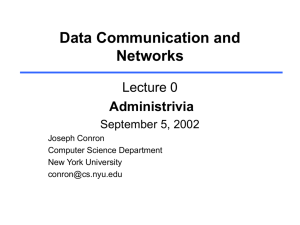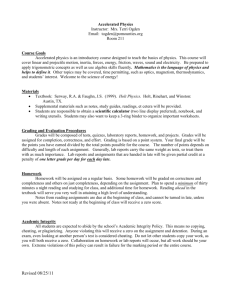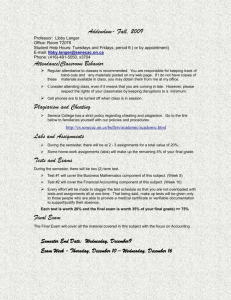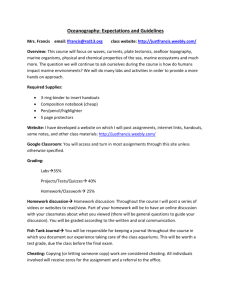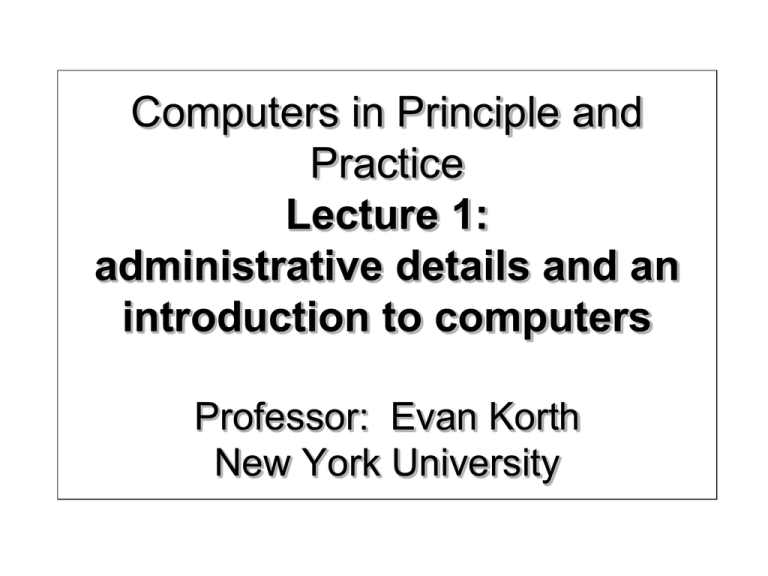
Computers in Principle and
Practice
Lecture 1:
administrative details and an
introduction to computers
Professor: Evan Korth
New York University
Road Map for Today
Welcome to Computers in Principle and Practice!
Course Description
– What material will we cover?
Goals
Preview of applications
Books
Administrative Issues
– Course Web Page, Exams, Office Hours, Homework,
Grading, Cheating Policy, Unix accounts, Computer
Labs
Syllabus
Introduction to Computers
2
Course Description
Official Description: The principles part of
the course introduces basic design
principles underlying a computer, including
topics in hardware and software for a variety
of systems. The practical component of the
course seeks to enable students to use
computers as a tool, no matter what
discipline they study, introducing them to
HTML, word processing, graphics,
spreadsheets, and the World Wide Web.
3
Course goals
There are two important elements to the
course:
– Principles (20%- 30% of the course):
Understanding the concepts behind computers
– Practice (70%- 80% of the course):
Learning how to use computers and applications
4
“Practice” specifics
We will discuss the following applications:
–
–
–
–
–
Word processing
Spreadsheets
Web authoring tools
Presentation software
Multimedia: animation and imaging applications
Plus:
– Basic operating system skills
You will be encouraged to use the computer as much as
possible, because this will be useful for you in your
college career and beyond.
5
“Principles” specifics
We will also discuss the concepts behind
computers, Networking, and Internet and the
web:
–
–
–
–
–
–
Computing Hardware
History of computing, the Internet and the web
Networking
How the Internet and the web work
Privacy, security, etc..
Current developments in the world of computers and
the Internet
6
Course Prerequisites
Prerequisites:
– No prior computing experience required (Really)
Students with computing experience should ask me if they should
be here..
– Three years of high school mathematics or equivalent.
Who should be taking this course:
– Students who want a computer applications minor
– Students who are not fully comfortable with computer
applications
– Students who want practical computer knowledge before they
graduate
Who should NOT be taking this course
– Students who know computers well and are trying to get an easy
A.
You must get a C or better in this class to take further
computer science classes.
7
Administrative Matters
8
Course Web Site
Course web site is available at:
http://www.cs.nyu.edu/courses/fall07/V22.0004003/index.html
Web site contains the following information:
–
–
–
–
–
–
–
–
–
Administrative information
Course Syllabus
Homework assignments
Readings
Class notes
Class resources
Tutoring information
Link to the class mailing list
The webpages you will build
9
Class mailing list
First assignment is to join it. Do it today!
Go to:
http://cs.nyu.edu/mailman/listinfo/v22_0004_003_fa07
and follow the instructions
All assignments and news will be sent to the
class list
Homework questions should be sent to the
list and answered by students when possible.
10
Software
Microsoft Office
– Microsoft Word (word processing: newsletters, reports, etc..)
– Power Point used for presentations
– Excel used for Spreadsheets and Simple databases
Web browsers:
– Safari, Firefox, Internet Explorer or Netscape
Multimedia, Imaging and Animation
– Adobe Photoshop, Image Ready and Flash
HTML editor:
– Macromedia Dreamweaver
Operating systems:
– Unix, Mac OX, Windows
11
Books
See syllabus
12
A Note about book selection
There are many other books that cover the same
topics, and you are welcome to explore other
computer books.
In addition, there are many tutorials and
resources on-line for learning about computers
and software.
We will post links to many on-line resources
during the semester. Please feel free to let us
know of sites that contain information and
examples which you think would be of benefit to
all of the students.
13
Computer labs
The labs will have all software needed for this
class.
You need to use your ID card to gain access.
The main computer labs that you will use are
(Apple Computers):
– Multimedia lab
Education Building
35 W. 4th Street (second floor)
– Third North Dorm
3rd Avenue and 12th street.
Tutors will be present at Third North lab 20
hours a week. Tutor hours will posted on course
homepage
There are other labs, although those are the main
two with Apple computers.
14
NYU network accounts
All NYU students are eligible for an NYUHome:
– Web based email
– PPP account: Allows you to connect from home if you
do not already have an internet connection
– You need to activate this account from this page:
– http://start.nyu.edu
For this course you have been assigned a special
UNIX Account called “i5”:
– used for developing your web site
– If you are a high school student, please speak to me
today to set you up with an account. You will not be
able to do it on your own.
15
Grading
Your grade will be determined as follows:
– Midterm (20%)
– Homework (possible quizzes) (50%)
– Final Exam (30%)
Class participation will help your grade!
16
Homework
There will be approximately nine assignments.
Homework is 50% of your grade
Be prepared to spend 10-20 hrs per week to work on
assignments.
It is important not to get behind in turning in
assignments.
If you do get behind, we still want you to do the
assignment, so it is better to turn in a late assignment than
to skip it.
However, late assignments will be severely penalized,
and may not be graded except to note that the assignment
was turned in.
Assignments that you turn in MUST be your own work.
It is fine to talk to other students about the assignments,
but you MUST hand in your own work.
Cheating will NOT be tolerated!
17
A Word About Cheating
For the purposes of this class, cheating is
defined as by the CS Department’s
academic integrity policy
– Discussing homework concepts is fine, but
you must submit your own work.
If you are caught cheating, you will
receive an immediate FAILURE for the
course.
18
Student Civility
In an effort to make this class enjoyable
for everybody…
– Please be on time to class!
– Please do not talk to your friends and
neighbors in class! It disturbs everyone, and
makes it hard to concentrate. If you have a
question, just ask me!
– Please turn your pagers and cell-phones off!
19
Getting Help
Help is always available!
Option 1: Come to my Office Hours
– Monday, Tuesday and Wednesday 3:30-4:30
(I may change the time of my office hours)
– Location: Room 419 Warren Weaver Hall
– I get bored when nobody visits!
– If you cannot make my office hours, I will be
happy to make an appointment with you.
Option 2: Write to the class mailing list. Please do
not send homework code to the list.
Option 3: Tutors
– Available at the ITS Third North Lab (20 hours a
week. Hours will be posted on the class website)
Option 4: Search the web
– You can find many tutorials and helpful tips
20
What Is a Computer?
Computer
– Performs computations and makes logical decisions
– Millions / billions times faster than human beings
Computer programs
– Sets of instructions by which a computer processes
data
Hardware
– Physical devices of computer system
Software
– Programs that run on computers
21
2003 Prentice Hall, Inc. All rights reserved.
(modified by Evan Korth)
Computer Organization
Six logical units of computer system
– Input unit
Mouse, keyboard
– Output unit
Printer, monitor, audio speakers
– Memory unit
Retains input and processed information
– Arithmetic and logic unit (ALU)
Performs calculations
– Central processing unit (CPU)
Supervises operation of other devices
– Secondary storage unit
Hard drives, floppy drives
22
2003 Prentice Hall, Inc. All rights reserved.
The boot process
The process by which a machine comes up from
rest state to the state that is usable is known as
booting
When the power is turned on
– The CPU runs the BIOS (Basic Input / Output
System)
Usually located on a chip on the motherboard
Runs POST (Power On Self Test) of various hardware
components
Loads the boot sector program
23
The boot process (continued)
– Boot Sector Program
Located in the first sector of the hard disk or
floppy disk
Is responsible for loading the rest of the operation
system into the RAM
– Operating System
Once it is loaded, it configures the various
hardware components
Then it waits for the user to issue commands
Then you can run your applications
24
Hardware Trends
Every year or two the following approximately
double:
– Amount of memory in which to execute programs
– Amount of secondary storage (such as disk storage)
Used to hold programs and data over the longer term
– Processor speeds
The speeds at which computers execute their programs
25
2003 Prentice Hall, Inc. All rights reserved.
History of the Internet
In the 1969, the Advanced Research Projects Agency of
the Department of Defense (ARPANet) funded research
to network its researching facilities and universities
The Internet enables
– Quick and easy communication via e-mail
– International networking of computers
Packet switching
– The transfer of digital data via small packets
– Allows multiple users to send and receive data simultaneously
No centralized control
– If one part of the Internet fails, other parts can still operate
Bandwidth
– Information carrying capacity of communications lines
26
2003 Prentice Hall, Inc. All rights reserved.
World Wide Web
Locate and view multimedia-based
documents on almost any subject
Makes information instantly and
conveniently accessible worldwide
Possible for individuals and small
businesses to get worldwide exposure
Changing the way business is done
27
2003 Prentice Hall, Inc. All rights reserved.

